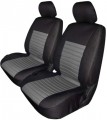Set
The number of separate heaters in the set, in other words, the number of seats that can be heated. On the market there are both single heaters and paired sets — usually designed for both front seats.
Heating element
The type of heating element used in the device.
-
Wire. A heating element in the form of a high-resistance alloy wire that generates heat when an electric current is passed through. Such heaters are relatively inexpensive, while they heat up quickly and retain heat for some time after switching on. On the other hand, wire is stiffer than carbon fibre and can be uncomfortable, and is also considered less reliable.
-
Carbon fibre. Heating elements based on carbon fibre are considered more durable and convenient than wire ones. Among other things, they are softer and do not stand out as much under the shell of the heating element; in addition, carbon fibre is more resistant to bending and folding. The disadvantages of this option are, firstly, a rather high cost, and secondly, a slightly lower heating rate.
Remote control
The presence of a remote control in the design of the heater.
In this case, the
remote control means, in fact, any controller made separately from the heater itself. Most often, such a “remote” is installed on a wire that connects the device to the cigarette lighter, or even on a plug: this design is very inexpensive, while it is quite affordable and functional. But the heating control buttons, which are equipped with
built -in models (see "Type"), are not considered a remote control.
Power
Power consumption of the device. When choosing, this parameter often has an exclusively reference value: the energy consumption of heating systems is not so high as to cause problems when connected to the on-board network, and the specific heater power is selected by the manufacturer in such a way that the device is able to effectively perform its functions.

